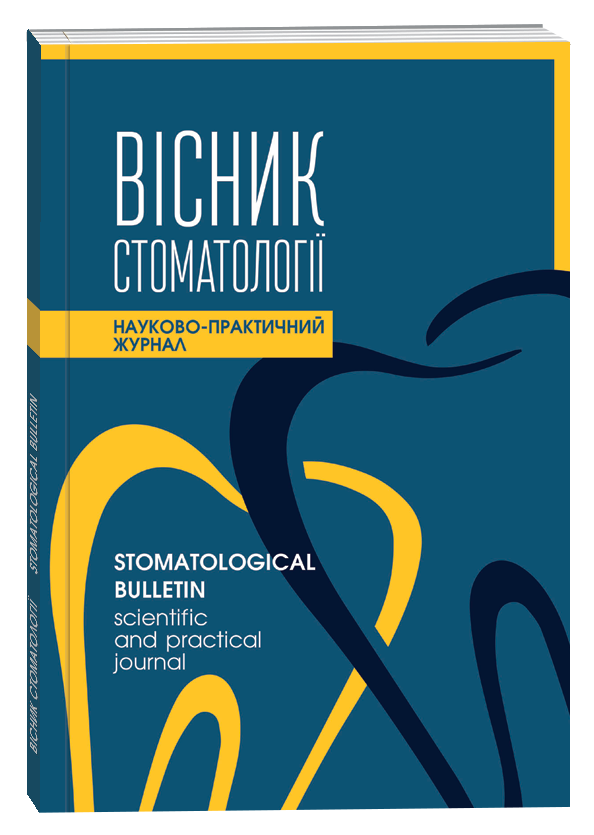NEW APPROACHES TO THE TREATMENT OF LOWER JAW ANGLE FRACTURE IN CHILDREN AGED 9-18 YEARS
DOI:
https://doi.org/10.35220/2078-8916-2022-43-1.15Keywords:
lower jaw angle fracture, children, osteosynthesisAbstract
In modern maxillofacial surgery, inclined titanium plates and screws for osteosynthesis are widely used to fix bone fragments in fractures of various localization, which in principle makes it possible to ensure reliable retention of fragments in three planes for the entire period of fracture consolidation. Purpose of the study. Determination of safe points for fixing miniplastins in the treatment of fractures of the lower jaw angle in children aged 9-18 years. Materials and methods of research. We analyzed the medical records of children aged 9 to 18 years with fractures of the corners of the lower jaw, who were treated by osteosynthesis in the maxillofacial departments of Dnipro city hospitals for the period from 2012 to 2022. When drawing up a treatment plan for fractures of the lower jaw angle, we analyzed 64 CT scans in children aged 9-18 years to determine safe areas of miniplast fixation. Tomograms were performed on a Planmeca tomograph. All patients were also given 64 orthopantomograms and analyzed. When conducting clinical studies of children aged 9-18 years with fractures of the angle of the lower jaw, who were treated for the last 10 years in children's maxillofacial departments (SHLV) in Dnipro, we identified 3 groups of children. Based on the data obtained during the study of orthopantomograms and computed tomograms, we determined safe points for drilling when fixing the miniplate during the treatment of fractures of the lower jaw angle by osteosynthesis in children aged 9-18 years. In addition, certain drilling points for screws can be used when developing a surgical template positioned on the teeth.
References
Natu, S. S., Pradhan, H., Gupta, H., Alam, S., Gupta, S., Pradhan, R. & Agarwal, A. An Epidemiological Study on Pattern and Incidence of Mandibular Fractures. Plastic Surgery International. 2012. Р. 1–7.
Bykowski P. N., James M. R., Daniali I. B., L. N., & Clavijo-Alvarez, J. A. The Epidemiology of Mandibular Fractures in the United States, Part 1: A Review of 13,142 Cases from the US National Trauma Data Bank. Journal of Oral and Maxillofacial Surgery. 2015. № 73(12). Р. 2361–2366.
Morris, C., Bebeau, N. P., Brockhoff, H., Tandon, R., & Tiwana, P. Mandibular Fractures: An Analysis of the Epidemiology and Patterns of Injury in 4,143 Fractures. Journal of Oral and Maxillofacial Surgery. 2015. № 73(5). 951.e1–951.e12. doi:10.1016/j.joms.2015.01.001.
OO Sanu, AOS., & Ayodele, M.O. Akeredolu Management of pediatric mandibular fracture using orthodontic vacuum-formed thermoplastic splint: A case report and review of literature. Nigerian journal of clinical practice. 2017. P. 637–641.
Pohranychna Kh.Р. Pryncypy likuvannja perelomiv nyzhn'oï shhelepy [Principles of treatment of lower jaw fractures]. Medycyna transportu Ukrai'ny – Transport medicine of Ukraine. 2013. № 3. Р. 86–90 [in Ukrainian].
Kim, M.Y., Kim, C.-H., Han, S.-J., & Lee, J.-H. A comparison of three treatment methods for fractures of the mandibular angle. International Journal of Oral and Maxillofacial Surgery. 2016. № 45(7). Р. 878–883. doi: 10.1016/j.ijom.2016.02.013. Epub 2016 Mar 14.
Ferrari, R., Lanzer, M., Wiedemeier, D., Rücker, M., & Bredell, M. Complication rate in mandibular angle fractures–one vs. two plates: a 12-year retrospective analysis. Oral and Maxillofacial Surgery. 2018. № 2(4). Р. 435–441. doi: 10.1007/s10006-018-0728-4. Epub 2018 Oct 16.









